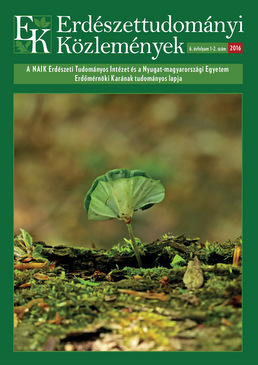| 1. | Horváth A. és Mátyás Cs. 2014: Növedékcsökkenés előrevetítése egy bükk származási kísérlet alapján. Erdészettudományi Közlemények, 4: 2, 91-99. full text |
| 2. | Kramer, K.; Degen, B.; Buschbom, J.; Hickler, T.; Thuiller ,W.; Sykes, M.T. et al. 2010: Modelling exploration of the future of European beech (Fagus sylvatica L.) under climate change - Range, abundance, genetic diversity and adaptive response. Forest Ecology and Management, 259 (11): 2213-2222. DOI: 10.1016/j.foreco.2009.12.023 |
| 3. | Mátyás, Cs. 1996: Climatic adaptation of trees: Rediscovering provenance tests. Euphytica, 92: (1-2) 45-54, DOI: 10.1007/BF00022827 |
| 4. | Mátyás Cs. 2002: Erdészeti-természetvédelmi genetika. Mezőgazda Kiadó, Budapest |
| 5. | Mátyás, Cs. 2016a: Recommendations for the choice of forest reproductive material in the face of climate change. FORGER Guidelines 2016, Biodiversity International, Rome, © Mátyás Csaba |
| 6. | Mátyás Cs. 2016b: Javaslatok az erdészeti szaporítóanyag megválasztásához a klímaváltozás fényében (a FORGER projekt eredményei alapján). Erdészeti Lapok, 151 (3): 78-82. full text |
| 7. | Mátyás, Cs. and Kramer, K. 2016: Climate change affects forest genetic resources: consequences for adaptive management. FORGER Policy Brief 2016. Biodiversity International, Rome, © Mátyás Csaba |
| 8. | Borovics A.; Nagy L.; Cseke K.; Bordács S. és Mátyás Cs. 2013: Genetikai monitoring: az evolúciós változások finom léptékű ellenőrzése. In: Faragó S. (szerk.): Monitoring az erdészetben és vadgazdálkodásban. Nyugat-magyarországi Egyetem, Sopron, 53-60. |
| 9. | Fares, S.; Mugnozza, G.S.; Corona, P. and Palahi, M. 2015: Sustainability: Five steps for managing Europe’s forests. Nature, 519 (7544): 407-409. DOI: 10.1038/519407a |
| 10. | Gálos B.; Mátyás Cs. and Jacob, D. 2011: Regional characteristics of climate change altering effects of afforestation. Environmental Research Letters, 6 (4): 1-9, Nr. 044010. DOI: 10.1088/1748-9326/6/4/044010 |
| 11. | Gálos B.; Mátyás Cs. és Jacob D. 2012: Az erdőtelepítés szerepe a klímaváltozás hatásának mérséklésében. Erdészettudományi Közlemények, 2 (1): 35-45. full text |
| 12. | Konnert, M.; Fady, B.; Gömöry, D.; A’Hara, S.; Wolter, F.; Ducci, F.; Koskela, J.; Bozzano, M.; Maaten, T. and Kowalczyk, J. 2015: Use and transfer of forest reproductive material in Europe in the context of climate change. European Forest Genetic Resources Programme (EUFORGEN), Bioversity International, Rome, XVI and 75 p. |
| 13. | Kramer, K. 2007: Resilience of European forests: towards a non-equilibrium view for the management of diversity. In: Koskela J.; Buck, A. and A. Teissier. du Cros (eds): Climate Change and Forest Genetic Diversity: implications for sustainable forest management in Europe. Biodiversity International, Rome, Italy, 43-52. |
| 14. | Kramer, K.; Buiteveld, .J; Forstreuter, M.; Geburek, T.; Leonardi, S.; Menozzi, P. et al. 2008: Bridging the gap between ecophysiological and genetic knowledge to assess the adaptive potential of European beech. Ecological Modelling, 216 (3-4): 333-353. DOI: 10.1016/j.ecolmodel.2008.05.004 |
| 15. | Lefèvre, F.; Boivin, T.; Bontemps, A.; Courbet, F.; Davi, H.; Durand-Gillmann, M. et al. 2013: Considering evolutionary processes in adaptive forestry. Annales of Forest Science, 71 (7): 723-739. |
| 16. | Lindner, M.; Maroschek, M.; Netherer, S.; Kremer, A.; Barbati, A.; Garcia-Gonzalo, J. et al. 2010: Climate change impacts, adaptive capacity, and vulnerability of European forest ecosystems. Forest Ecology and Management, 259 (4): 698-709. DOI: 10.1016/j.foreco.2009.09.023 |
| 17. | Mátyás, Cs. 2010: Forecasts needed for retreating forests (Opinion). Nature, 464:(7293) 1271. DOI: 10.1038/4641271a |
| 18. | Mátyás Cs. 2011: Elegendő a természetre bízni a jövőt? Erdészeti Lapok, 146: (5) 140-141. full text |
| 19. | Mátyás, Cs. (ed) 2010: Forests and Climate Change in Eastern Europe and Central Asia. Forests and Climate Change Working Paper Nr. 8, Food and Agriculture Organisation of the United Nations, Rome |
| 20. | Mátyás, Cs.; Berki, I.; Czúcz, B.; Gálos, B.; Móricz, N. and Rasztovits, E. 2010: Future of beech in Southeast Europe from the perspective of evolutionary ecology. Acta Silvatica & Lignaria Hungarica, 6: 91-110. full text |
| 21. | Mátyás Cs.; Führer E.; Berki I.; Csóka Gy.; Drüszler Á.; Lakatos F.; Móricz N.; Rasztovics E.; Somogyi Z.; Veperdi G.; Vig P. és Gálos B. 2010: Erdők a szárazsági határon. Klíma 21 füzetek, 61: 84-97. |
| 22. | Mátyás Cs. és Gálos B. 2010: Erdőgazdálkodás és klimatikus szélsőségek: problémák és feladatok. Klíma 21 füzetek, 63: 25-32. |
| 23. | Mátyás, Cs.; Sun, G. and Zhang, Y. 2013: Afforestation and forests at the dryland edges: lessons learned and future outlooks. In: Chen, J.; Wan, S.; Henebry, G.; Qi, J.; Gutman, G.; Sun, G. and Kappas, M. (eds): Dryland East Asia: |
| 24. | Land dynamics amid social and clmate change. HEP Publishers, Beijing & Walter de Gruyter and Co., Berlin, 245-264. DOI: 10.1515/9783110287912.245 |
| 25. | Mátyás, Cs. and Sun, G. 2014: Forests in a water limited world under climate change. Environmental Research Letters, 9 Nr. 085001 DOI: 10.1088/1748-9326/9/8/085001 |
| 26. | Rasztovits, E.; Móricz, N.; Berki, I.; Pötzelsberger, E. and Mátyás, Cs. 2012: Evaluating the performance of stochastic distribution models for European beech at low-elevation xeric limits. Időjárás, 116:(3) 173-194. |
